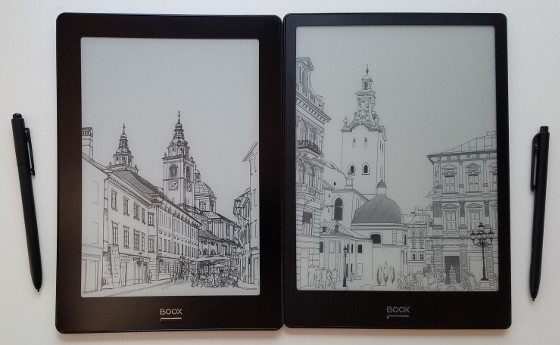Onyx recently released the new Onyx Boox Note S with a 9.7-inch E Ink screen. It pretty much has the same exact features as the 10.3-inch Onyx Boox Note that was released a few months ago, except the Note S is cheaper so it comes with some downgrades.
See my Onyx Boox Note review for a closer look at it, and I’ll post a full review of the Note S soon.
Here’s a summary of how the two models compare:
Similarities
Both run the same Android 6.0 software and have the same software features and the same included apps (except Google Play doesn’t work on the Note S).
They have the same 1.6GHz quad-core processor.
Both have capacitive touchscreens and both come with a stylus pen to write on the screen.
Both have similar designs with a back button below the screen, a USB-C port on the lower edge, two speakers on the back, and a power button on the top edge.
Both have Wi-Fi and Bluetooth.
Neither have frontlights.
The Note S stylus is slightly larger but they both have the same hard plastic tip with an eraser on the top and there’s a button you can press to activate erasing with the tip. However, they use different technologies so they aren’t interchangeable.
Key Differences
The 10.3 Note has 32GB of storage space and 2GB of RAM; the 9.7 Note has 16GB of storage space and 1GB of RAM. Neither has a memory card slot.
The Google Play Store does not work on the 9.7 Note S; it gives an uncertified Android device error. I don’t know if they will fix that or not but you can still sideload apps from other sources.
The Note S is more prone to bogging down and not responding, possibly because of less RAM or perhaps a bug.
The 9.7-inch Note S has a flush glass screen and a glass-based E Ink Carta display with a resolution of 1200 x 825 (150 ppi). Because of the lower resolution, text appears a bit fuzzier and bolder.
The 10.3-inch Note has a flexible E Ink Carta screen with no glass and it has a resolution of 1872 x 1404 (227 ppi). Text is noticeably clearer and sharper with the extra 77 pixels per inch.
The 10.3 Note has a Wacom touchscreen with support for 4096 levels of pressure sensitivity; the Note S has a lower grade Hanvon touchscreen with support for 1024 levels of pressure sensitivity.
With the glass screen, the Note S is heavier at about 400 grams, whereas the 10.3 Note weighs 334 grams.
In addition to being lighter, the 10.3 Note is slimmer at 6.8mm—the Note S is 8.2mm.
Writing on the glass screen feels less natural and kind of awkward but that can probably be remedied with a screen protector.
The glass screen is more resistant to scratches; the 10.3 Note’s screen can show marks and scratches if you press down really hard with the stylus when not using a screen protector.
Because of the low resolution screen, the Kindle app doesn’t work as well on the Note S. Everything is scaled up and the smallest font size is too large and the margins are huge.
The 10.3 Note has a larger battery (4100mAh vs 3000mAh).
The retail price of the Boox Note S is $389 and the 10.3 Boox Note sells for $549.


Thanks for the video. Other than the expected quality differences, very hard to see a big difference between the two, especially if the play store issue is causing the slowness. It’s hard to tell if the note s still has a matte look to diffuse glare?
Thanks for the video review, very helpful.
The screen on the Note S doesn’t have a matte layer; it’s basically the same kind of look and feel as other flush glass screens like on the Kindle Oasis and Kobo Aura One. It’s a bit more reflective than my 10.3 Note’s screen but it has a screen protector on it that has a light matte quality, which definitely feels a lot better for writing than the slick glass. I’m starting to turn against these glass screens. They look cool but add nothing to the reading experience and just add more weight and glossiness that takes away clarity and they’re slicker to hold onto. I liked it better when ebooks readers were their own separate devices with page buttons and super clear screens before they started trying to copy phone and tablet designs.
Very good video – thank you. Battery life is a huge deal for me. How does the bigger Note’s battery hold up for aggressive book reading – say 2 – 3 hours per day? Does it last at least a week? Also is the app that’s being used to read PDFs the same as the app used for EPUBs? What is the preferred reading app for such documents?
Sorry but I’m always having to go back and forth between devices to review so it’s hard to get a sense on battery life. If just reading it should last about a week reading 2-3 hours per day. Using Wi-Fi and apps drains the battery a lot faster. Onyx’s app for ePubs and PDFs is NeoReader and it works well.
Thank you for writing this review — it was hard to get info on the S. That said, can you update to let people know that Google Play DOES work now? This was a major deciding factor for me and many people might be turned away based on your review. I just purchased the Note S and there are instructions now on the Onyx Boox FAQ that show how to easy fix the Google Play issue. (I’m not very tech savvy at all, and I was able to do it 🙂